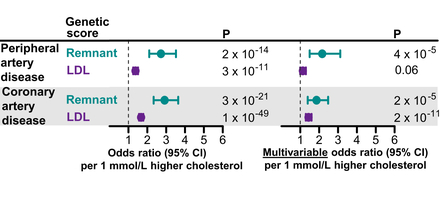Final ID: MDP149
Elevated remnant cholesterol, LDL cholesterol, and risk of peripheral artery disease: a Mendelian randomization study
Abstract Body (Do not enter title and authors here): Background: Elevated remnant cholesterol and low-density lipoprotein (LDL) cholesterol both increase risk of coronary artery disease (CAD), but it is not known if the same is true for peripheral artery disease (PAD).
Hypothesis: We tested the hypothesis that elevated remnant cholesterol and LDL cholesterol, each independent of the other, have causal effects on risk of PAD.
Methods: We constructed genetic scores from variants near genes known to directly affect levels of remnant cholesterol and LDL cholesterol, identified through a genome-wide association study of individuals in the UK Biobank. We used univariable (remnant cholesterol and LDL cholesterol genetic scores separately) and multivariable (remnant cholesterol and LDL cholesterol genetic scores combined) Mendelian randomization to estimate the causal effects of higher remnant cholesterol and LDL cholesterol levels on odds ratios for PAD (N = 38,414 cases and 758,308 controls) and CAD (N = 221,445 cases and 770,615 controls).
Results: Increments in remnant and LDL genetic scores corresponding to 1 mmol/L (39 mg/dL) higher remnant and LDL cholesterol, respectively, were associated with univariable odds ratios for PAD of 2.72 (95% confidence interval: 2.10-3.52) and 1.37 (1.25-1.51), respectively (Image 1); corresponding multivariable odds ratios were 2.16 (1.49-3.12) and 1.14 (1.00-1.30), respectively. For CAD, corresponding univariable odds ratios were 2.92 (2.34-3.64) and 1.67 (1.56-1.79), while multivariable odds ratios were 1.86 (1.39-2.47) and 1.44 (1.29-1.60), respectively.
Conclusions: Elevated remnant cholesterol had a causal effect on risk of PAD even after accounting for elevated LDL cholesterol, whereas most of the causal effect from elevated LDL cholesterol on risk of PAD was dependent on simultaneously elevated remnant cholesterol. These results indicate that remnant cholesterol may be the major cholesterol fraction responsible for increased risk of PAD, which calls for clinical trials to test if remnant cholesterol-lowering therapy could prevent PAD.
Hypothesis: We tested the hypothesis that elevated remnant cholesterol and LDL cholesterol, each independent of the other, have causal effects on risk of PAD.
Methods: We constructed genetic scores from variants near genes known to directly affect levels of remnant cholesterol and LDL cholesterol, identified through a genome-wide association study of individuals in the UK Biobank. We used univariable (remnant cholesterol and LDL cholesterol genetic scores separately) and multivariable (remnant cholesterol and LDL cholesterol genetic scores combined) Mendelian randomization to estimate the causal effects of higher remnant cholesterol and LDL cholesterol levels on odds ratios for PAD (N = 38,414 cases and 758,308 controls) and CAD (N = 221,445 cases and 770,615 controls).
Results: Increments in remnant and LDL genetic scores corresponding to 1 mmol/L (39 mg/dL) higher remnant and LDL cholesterol, respectively, were associated with univariable odds ratios for PAD of 2.72 (95% confidence interval: 2.10-3.52) and 1.37 (1.25-1.51), respectively (Image 1); corresponding multivariable odds ratios were 2.16 (1.49-3.12) and 1.14 (1.00-1.30), respectively. For CAD, corresponding univariable odds ratios were 2.92 (2.34-3.64) and 1.67 (1.56-1.79), while multivariable odds ratios were 1.86 (1.39-2.47) and 1.44 (1.29-1.60), respectively.
Conclusions: Elevated remnant cholesterol had a causal effect on risk of PAD even after accounting for elevated LDL cholesterol, whereas most of the causal effect from elevated LDL cholesterol on risk of PAD was dependent on simultaneously elevated remnant cholesterol. These results indicate that remnant cholesterol may be the major cholesterol fraction responsible for increased risk of PAD, which calls for clinical trials to test if remnant cholesterol-lowering therapy could prevent PAD.
More abstracts on this topic:
Additive Value of Lipoprotein(a), Remnant Cholesterol, and Inflammation for Risk Stratification of Myocardial Infarction: Evidence from the UK Biobank
Kazibwe Richard, Schaich Christopher, Kingsley Jeffrey, Rikhi Rishi, Namutebi Juliana, Chevli Parag, Mirzai Saeid, Shapiro Michael
Association of the Alternative Healthy Eating Index with Coronary Artery Calcification Volume and Density: the Multi-Ethnic Study of AtherosclerosisCannon Ethan, Mcclelland Robyn, Wood Alexis, Budoff Matthew, Allison Matthew, Criqui Michael, Jacobs David, Lutsey Pamela

